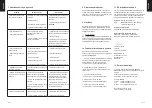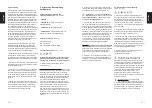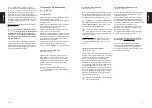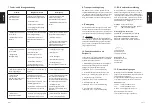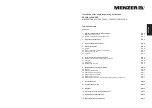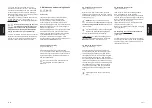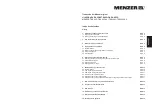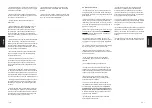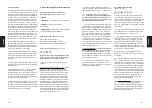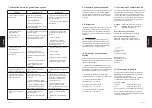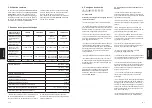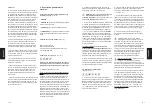
8 EN
EN 9
ENGLISH
ENGLISH
4.4 Kickback
Kickback is a sudden reaction to a jammed,
snagged or blocked insertable tool such as the
abrasive or the driving disc. The rotation of the
insertable tool is brought to a sudden halt by
this blocking action. As a counter-reaction this
accelerates the power tool against the rotational
direction of the insertable tool at the point where
the blocking takes place. E.g. if a sanding wheel
or the work piece snags or jams, the edge of the
sanding disc, which dips into the work piece, can
snag and break the sanding disc, or the Velcro
can let go or it can react with a kickback. The
sanding disc can jump towards the operator or
away from him, depending on the direction of rota
-
tion of the sanding disc at the snag point. This can
also cause the sanding discs to break.
Kickback is the result of wrong or incorrect use
of the machine, incorrect working methods and/
or adverse operating conditions. The following
precautions minimize the risk of kickback:
• Hold the machine firmly with both hands and
place your arms and your body so that you have
maximum control over kickback forces and torque
reaction.
• Never position your hand near the rotating
insertable tools because they can kick back over
your hand.
• Both the operator and other persons, stay clear
from the area in which the power tool moves when
it kicks back as the machine accelerates against
the direction of rotation of the abrasive at the snag
point.
• Use extreme caution when working close to
corners and sharp edges, for instance, do not let
the power tool jump back or jam in these areas.
The consequences would be loss of control and
kickback.
5. General description of the machine
5.1 Machine representations and type
descriptions
(page *2* and *3*)
• TBS 225
• TBS 225 AV
(with integrated vacuum dust
extraction)
• TSW 225
(with replaceable head system)
• TSW 225 AV
(with replaceable head system and
integrated vacuum dust extraction)
5.2 Controls
(page *4*)
A: Pushbutton safety guard
B: On/off button
C: Rotation speed control knob [MIN–MAX]
5.3 Starting off
(page *5*–*10*)
Attention! The power plug has to be pulled
from the wall socket or not plugged in for all
the actions/operations described below!
a. Remove the respective machine from the
package.
In TSW devices (page *5* and *6*): Remove
the body of the machine (main unit) and the
round or triangular replaceable head from
the package. Open the locking mechanism
of the replaceable head by pressing the two
levers on the outside of the unit (1a.). Push
the replaceable head and main unit of the
machine together via the joining elements for
a form-locked fit. Make sure that the drive pin
is aligned correctly. Then release the clasp
levers of the head attachment (2a.).
To replace the replaceable head, loosen
the locking mechanism on the lever on the
main body of the machine and separate the
replaceable head from the main body of the
machine by pulling it upwards (3a. and 4a.).
b. Attach a suitable abrasive to the sanding
pad on the driving disc of the machine (1b.
and 2b. – refer to page *7*). Make sure that it
is centred on the disc.
Attention!
To ensure that the working
environment is as
dust free
as possible, the
suction openings must match
the openings of
the sanding pad.
c. Connect an industrial vacuum cleaner to the
machine using the click or a plug-in system. Fol
-
low the instructions in the images on page *8* (1c.
and 2c.) to connect an industrial vacuum cleaner
by means of the MENZER system. If a MENZER
universal adapter must be used in between, follow
the instructions (1d.–3d. to connect the adapter –
refer to page *9*, 1e.–3e. to connect an industrial
vacuum cleaner to the adapter – refer to page
*10*). Make sure that a dust bag suitable for fine
dust is inserted in the industrial vacuum cleaner
beforehand.
AV machines do not require a connected
industrial vacuum cleaner,
as they have an
integrated extraction system. Only connect our
M-certified dust bag system to these machines
(refer to point 10 for Functional accessories and
peripherals).
d. Before connecting the machine to the power
outlet, make sure that the on/off button of the
machine is not pressed in and then plug it in.
5.4 Settings and handling
(page *11*–*13*)
a. You can first turn on the industrial vacuum
cleaner and then the drywall sander. Hold the
machine firmly and press the button. At the same
time unlock the crosswise safety catch (A and B –
refer to page *11*). Expect a rotational effect when
you switch the machine on.
b. Hold the drywall sander with both hands on the
insulated grip zones (D1 and D2 – refer to page
*11*).
c. The rotational and stroke speed can be con
-
tinuously adjusted as needed using the rotation
speed control knob (C – refer to page *11*). This
is also possible while the machine is in operation.
Higher rotational or stroke rates allow a higher
material removal rate, while lower rotational or
stroke rates ensure more control of the sanding
process.
d. Start the sanding process by carefully placing
the machine on the surface to be sanded.
Only apply enough pressure for the sanding
head to rest flat and flush on the surface.
Too much pressure can cause spiral scratch
patterns and bumps on the work surface and also
permanently damage the tool. We recommend a
circular, overlapping motion of the sanding head
on the work surface. The sander should stay in
motion until the desired smoothness has been
reached, as too long sanding in one spot can lead
to sanding marks.
In TSW devices: The triangular sanding
head does not have a rotating, but an
oscillating sanding motion. Less pressure should
be applied in the corners to protect the tips of the
head against overload and deformation.



